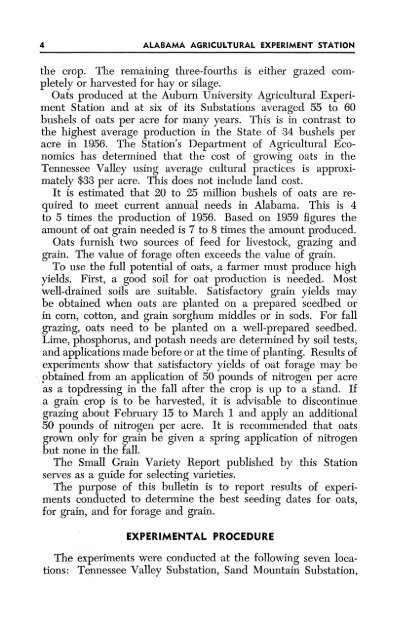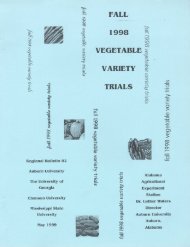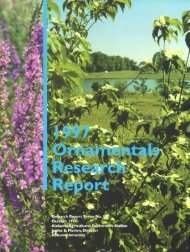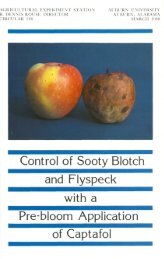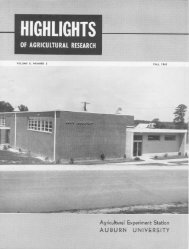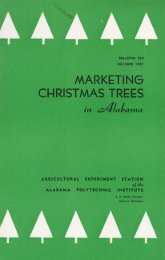PLANTING DATES OATS - Auburn University Repository
PLANTING DATES OATS - Auburn University Repository
PLANTING DATES OATS - Auburn University Repository
You also want an ePaper? Increase the reach of your titles
YUMPU automatically turns print PDFs into web optimized ePapers that Google loves.
4 ALABAMA AGRICULTURAL EXPERIMENT STATION<br />
the crop. The remaining three-fourths is either grazed completely<br />
or harvested for hay or silage.<br />
Oats produced at the <strong>Auburn</strong> <strong>University</strong> Agricultural Experiment<br />
Station and at six of its Substations averaged 55 to 60<br />
bushels of oats per acre for many years. This is in contrast to<br />
the highest average production in the State of 34 bushels per<br />
acre in 1956. The Station's Department of Agricultural Economics<br />
has determined that the cost of growing oats in the<br />
Tennessee Valley using average cultural practices is approximately<br />
$33 per acre. This does not include land cost.<br />
It is estimated that 20 to 25 million bushels of oats are required<br />
to meet current annual needs in Alabama. This is 4<br />
to 5 times the production of 1956. Based on 1959 figures the<br />
amount of oat grain needed is 7 to 8 times the amount produced.<br />
Oats furnish two, sources of feed for livestock, grazing and<br />
grain. The value of forage often exceeds the value of grain.<br />
To use the full potential of oats, a farmer must produce high<br />
yields. First, a good soil for oat production is needed. Most<br />
well-drained soils are suitable. Satisfactory grain yields may<br />
be obtained when oats are planted on a prepared seedbed or<br />
in corn, cotton, and grain sorghum middles or in sods. For fall<br />
grazing, oats need to be planted on a well-prepared seedbed.<br />
Lime, phosphorus, and potash needs are determined by soil tests,<br />
and applications made before or at the time of planting. Results of<br />
experiments show that satisfactory yields of oat forage may be<br />
obtained from an application of 50 pounds of nitrogen per acre<br />
as a topdressing in the fall after the crop is up to a stand. If<br />
a grain crop is to be harvested, it is advisable to discontinue<br />
grazing about February 15 to March 1 and apply an additional<br />
50 pounds of nitrogen per acre. It is recommended that oats<br />
grown only for grain be given a spring application of nitrogen<br />
but none in the fall.<br />
The Small Grain Variety Report published by this Station<br />
serves as a guide for selecting varieties.<br />
The purpose of this bulletin is to report results of experiments<br />
conducted to determine the best seeding dates for oats,<br />
for grain, and for forage and grain.<br />
EXPERIMENTAL PROCEDURE<br />
The experiments were conducted at the following seven locations:<br />
Tennessee Valley Substation, Sand Mountain Substation,


